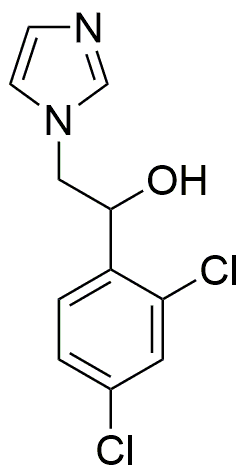1-(2,4-Dichlorophenyl)-2-(1-imidazolyl)ethanol is widely utilized in research focused on:
- Pharmaceutical Development: This compound is often explored for its potential as an antifungal agent, making it valuable in the development of new medications for treating fungal infections.
- Agricultural Chemistry: Its properties can be harnessed in formulating pesticides, providing effective solutions for crop protection against fungal pathogens.
- Biochemical Research: Researchers use this compound to study its interactions with biological systems, particularly in understanding enzyme inhibition and metabolic pathways.
- Material Science: It can be incorporated into polymers to enhance their antimicrobial properties, leading to safer materials for medical devices and packaging.
- Environmental Science: The compound is examined for its role in bioremediation processes, helping to break down pollutants in contaminated environments.
Informations générales
Propriétés
Sécurité et réglementation
Applications
1-(2,4-Dichlorophenyl)-2-(1-imidazolyl)ethanol is widely utilized in research focused on:
- Pharmaceutical Development: This compound is often explored for its potential as an antifungal agent, making it valuable in the development of new medications for treating fungal infections.
- Agricultural Chemistry: Its properties can be harnessed in formulating pesticides, providing effective solutions for crop protection against fungal pathogens.
- Biochemical Research: Researchers use this compound to study its interactions with biological systems, particularly in understanding enzyme inhibition and metabolic pathways.
- Material Science: It can be incorporated into polymers to enhance their antimicrobial properties, leading to safer materials for medical devices and packaging.
- Environmental Science: The compound is examined for its role in bioremediation processes, helping to break down pollutants in contaminated environments.
Documents
Fiches de données de sécurité (FDS)
La FDS fournit des informations de sécurité complètes sur la manipulation, le stockage et l’élimination du produit.
Spécifications du produit (PS)
Le PS fournit une description complète des propriétés du produit, notamment sa composition chimique, son état physique, sa pureté et les exigences de stockage. Il détaille également les plages de qualité acceptables et les applications prévues du produit.
Certificats d'analyse (COA)
Recherchez des certificats d'analyse (COA) en saisissant le numéro de lot du produit. Les numéros de lot et de lot se trouvent sur l'étiquette d'un produit, après les mots « Lot » ou « Lot de fabrication ».
Numéro de catalogue
Numéro de lot/série
Certificats d'origine (COO)
Ce certificat d'exploitation confirme le pays dans lequel le produit a été fabriqué, et détaille également les matériaux et composants utilisés et s'il est issu de sources naturelles, synthétiques ou autres sources spécifiques. Ce certificat peut être requis pour les douanes, le commerce et la conformité réglementaire.
Numéro de catalogue
Numéro de lot/série
Fiches de données de sécurité (FDS)
La FDS fournit des informations de sécurité complètes sur la manipulation, le stockage et l’élimination du produit.
DownloadSpécifications du produit (PS)
Le PS fournit une description complète des propriétés du produit, notamment sa composition chimique, son état physique, sa pureté et les exigences de stockage. Il détaille également les plages de qualité acceptables et les applications prévues du produit.
DownloadCertificats d'analyse (COA)
Recherchez des certificats d'analyse (COA) en saisissant le numéro de lot du produit. Les numéros de lot et de lot se trouvent sur l'étiquette d'un produit, après les mots « Lot » ou « Lot de fabrication ».
Numéro de catalogue
Numéro de lot/série
Certificats d'origine (COO)
Ce certificat d'exploitation confirme le pays dans lequel le produit a été fabriqué, et détaille également les matériaux et composants utilisés et s'il est issu de sources naturelles, synthétiques ou autres sources spécifiques. Ce certificat peut être requis pour les douanes, le commerce et la conformité réglementaire.


